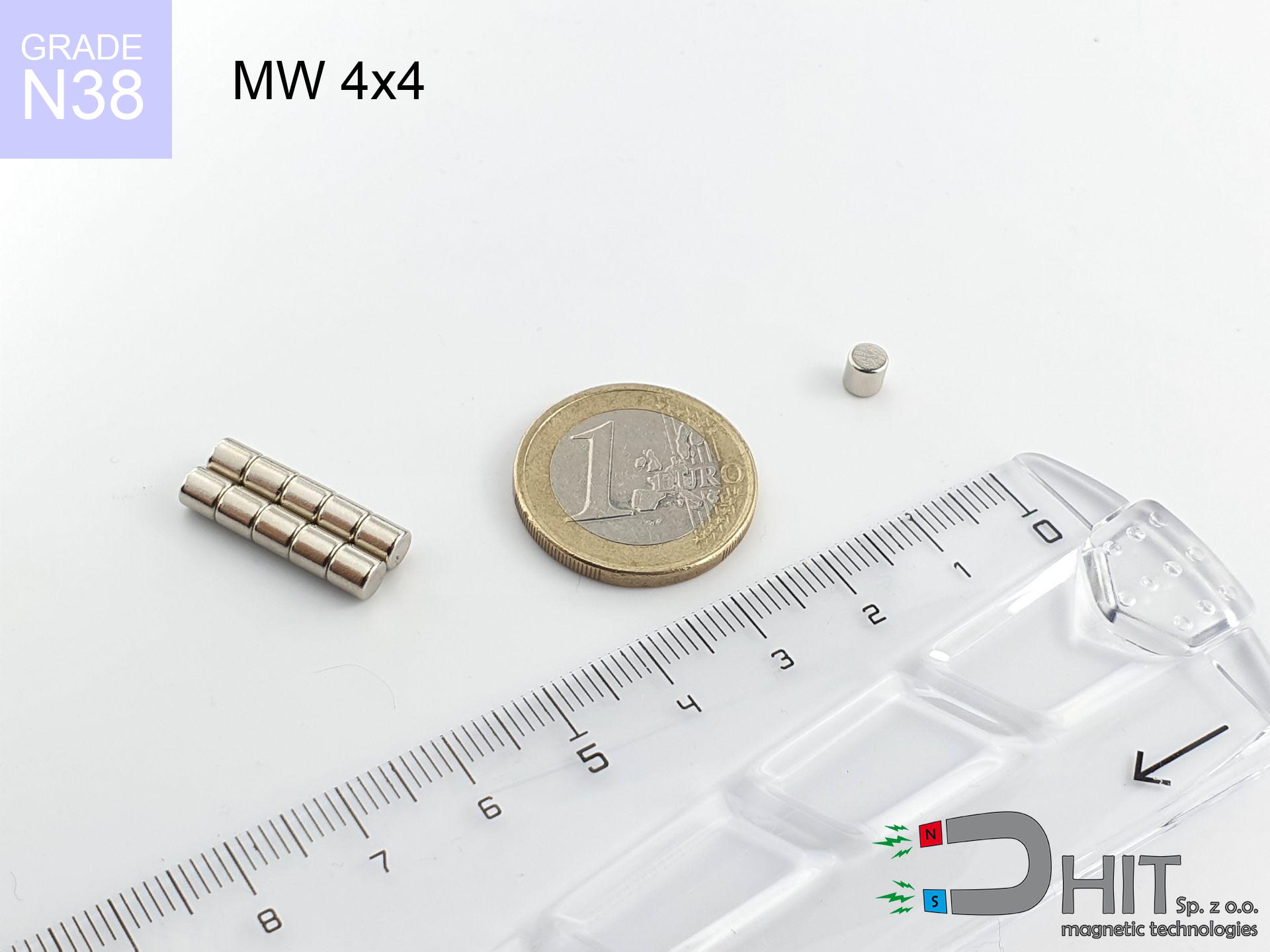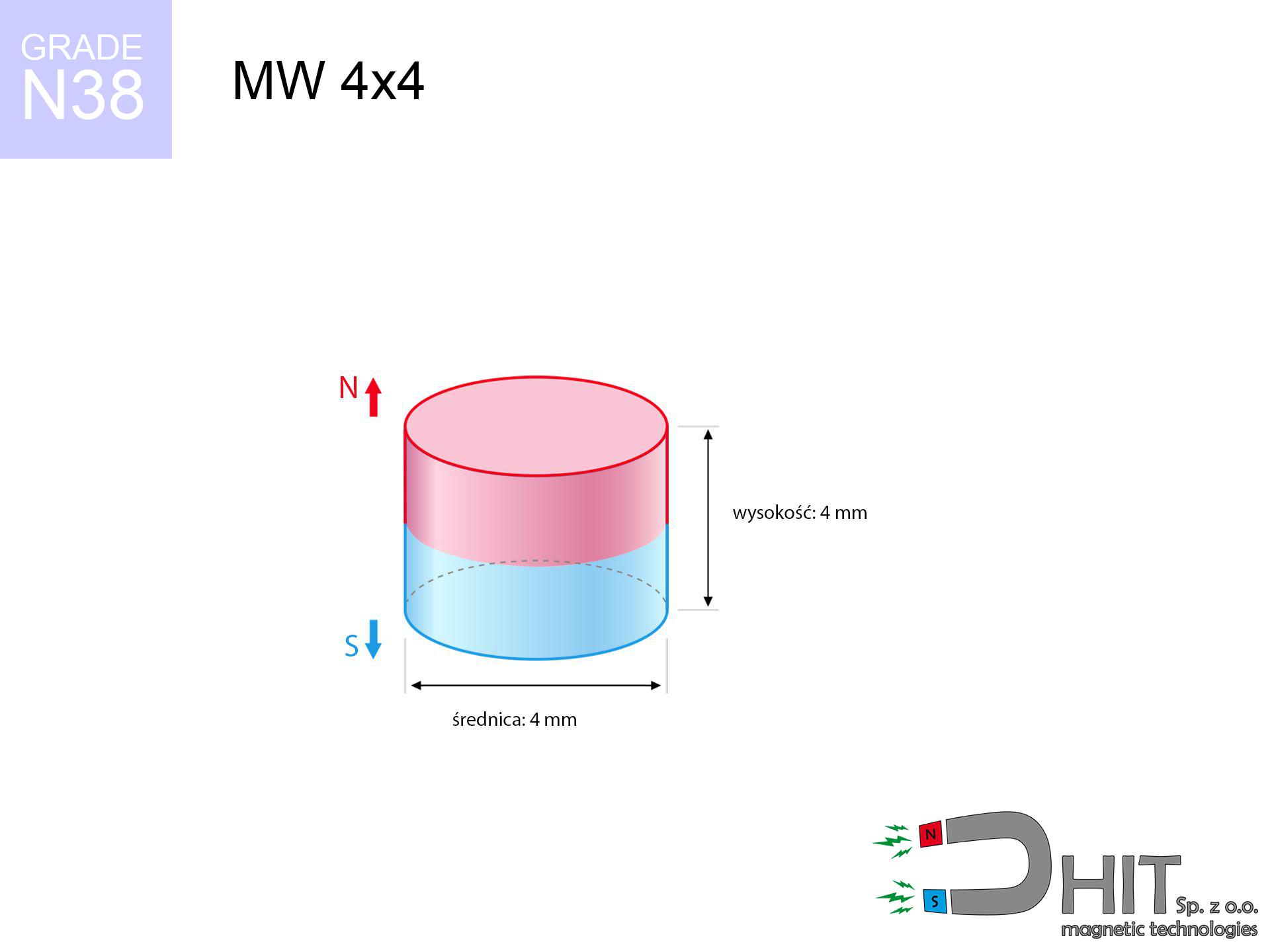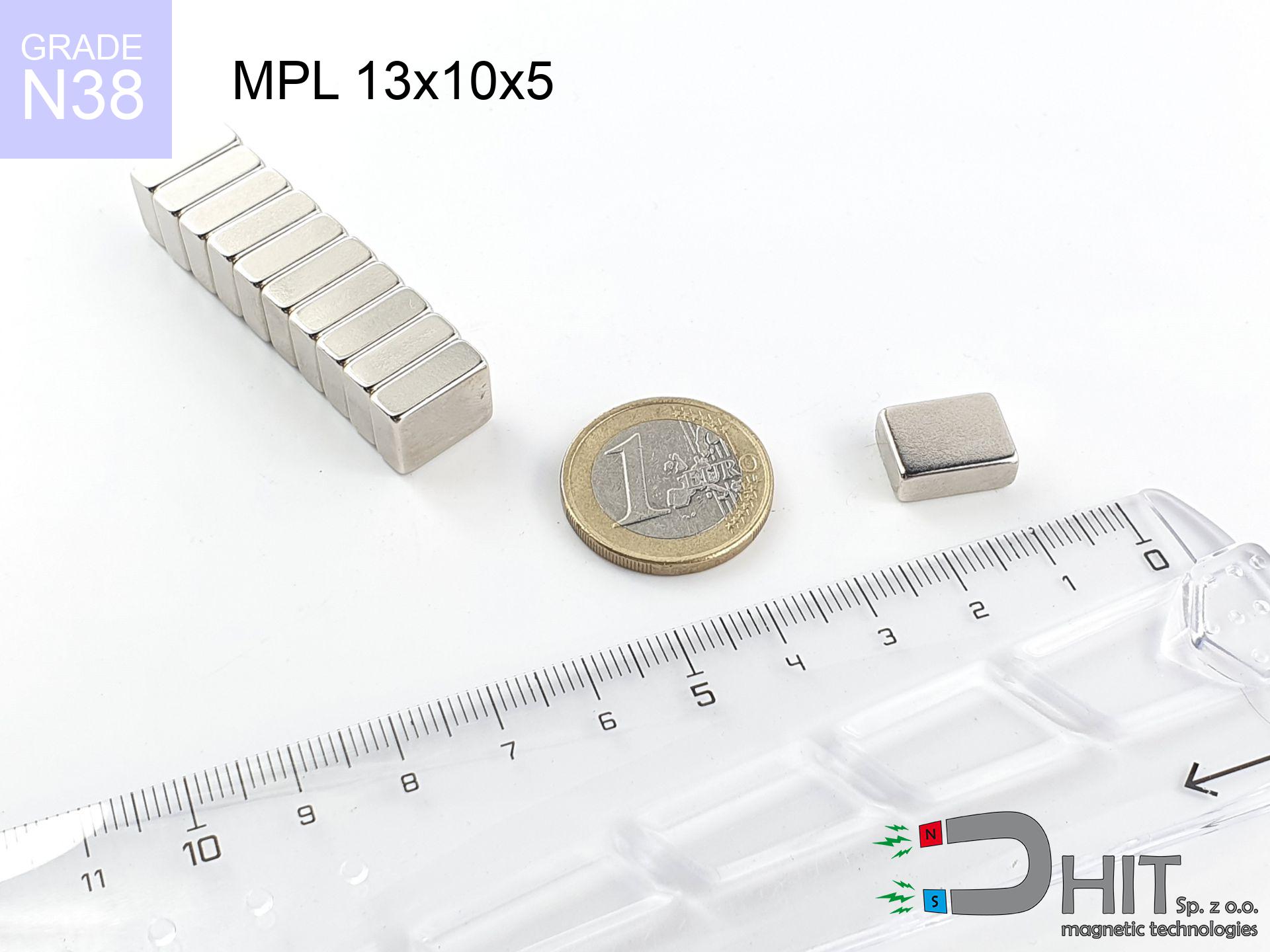MW 4x4 / N38 - cylindrical magnet
cylindrical magnet
Catalog no 010076
GTIN/EAN: 5906301810759
Diameter Ø
4 mm [±0,1 mm]
Height
4 mm [±0,1 mm]
Weight
0.38 g
Magnetization Direction
↑ axial
Load capacity
0.51 kg / 4.96 N
Magnetic Induction
552.79 mT / 5528 Gs
Coating
[NiCuNi] Nickel
0.406 ZŁ with VAT / pcs + price for transport
0.330 ZŁ net + 23% VAT / pcs
bulk discounts:
Need more?
Contact us by phone
+48 22 499 98 98
if you prefer contact us via
our online form
through our site.
Parameters as well as structure of magnetic components can be reviewed on our
force calculator.
Orders placed before 14:00 will be shipped the same business day.
Technical details - MW 4x4 / N38 - cylindrical magnet
Specification / characteristics - MW 4x4 / N38 - cylindrical magnet
| properties | values |
|---|---|
| Cat. no. | 010076 |
| GTIN/EAN | 5906301810759 |
| Production/Distribution | Dhit sp. z o.o. |
| Country of origin | Poland / China / Germany |
| Customs code | 85059029 |
| Diameter Ø | 4 mm [±0,1 mm] |
| Height | 4 mm [±0,1 mm] |
| Weight | 0.38 g |
| Magnetization Direction | ↑ axial |
| Load capacity ~ ? | 0.51 kg / 4.96 N |
| Magnetic Induction ~ ? | 552.79 mT / 5528 Gs |
| Coating | [NiCuNi] Nickel |
| Manufacturing Tolerance | ±0.1 mm |
Magnetic properties of material N38
| properties | values | units |
|---|---|---|
| remenance Br [min. - max.] ? | 12.2-12.6 | kGs |
| remenance Br [min. - max.] ? | 1220-1260 | mT |
| coercivity bHc ? | 10.8-11.5 | kOe |
| coercivity bHc ? | 860-915 | kA/m |
| actual internal force iHc | ≥ 12 | kOe |
| actual internal force iHc | ≥ 955 | kA/m |
| energy density [min. - max.] ? | 36-38 | BH max MGOe |
| energy density [min. - max.] ? | 287-303 | BH max KJ/m |
| max. temperature ? | ≤ 80 | °C |
Physical properties of sintered neodymium magnets Nd2Fe14B at 20°C
| properties | values | units |
|---|---|---|
| Vickers hardness | ≥550 | Hv |
| Density | ≥7.4 | g/cm3 |
| Curie Temperature TC | 312 - 380 | °C |
| Curie Temperature TF | 593 - 716 | °F |
| Specific resistance | 150 | μΩ⋅cm |
| Bending strength | 250 | MPa |
| Compressive strength | 1000~1100 | MPa |
| Thermal expansion parallel (∥) to orientation (M) | (3-4) x 10-6 | °C-1 |
| Thermal expansion perpendicular (⊥) to orientation (M) | -(1-3) x 10-6 | °C-1 |
| Young's modulus | 1.7 x 104 | kg/mm² |
Engineering modeling of the magnet - technical parameters
Presented data constitute the outcome of a physical simulation. Values rely on algorithms for the material Nd2Fe14B. Operational parameters might slightly differ. Please consider these calculations as a reference point for designers.
Table 1: Static pull force (force vs gap) - characteristics
MW 4x4 / N38
| Distance (mm) | Induction (Gauss) / mT | Pull Force (kg/lbs/g/N) | Risk Status |
|---|---|---|---|
| 0 mm |
5517 Gs
551.7 mT
|
0.51 kg / 1.12 pounds
510.0 g / 5.0 N
|
low risk |
| 1 mm |
2984 Gs
298.4 mT
|
0.15 kg / 0.33 pounds
149.2 g / 1.5 N
|
low risk |
| 2 mm |
1498 Gs
149.8 mT
|
0.04 kg / 0.08 pounds
37.6 g / 0.4 N
|
low risk |
| 3 mm |
803 Gs
80.3 mT
|
0.01 kg / 0.02 pounds
10.8 g / 0.1 N
|
low risk |
| 5 mm |
296 Gs
29.6 mT
|
0.00 kg / 0.00 pounds
1.5 g / 0.0 N
|
low risk |
| 10 mm |
58 Gs
5.8 mT
|
0.00 kg / 0.00 pounds
0.1 g / 0.0 N
|
low risk |
| 15 mm |
20 Gs
2.0 mT
|
0.00 kg / 0.00 pounds
0.0 g / 0.0 N
|
low risk |
| 20 mm |
9 Gs
0.9 mT
|
0.00 kg / 0.00 pounds
0.0 g / 0.0 N
|
low risk |
| 30 mm |
3 Gs
0.3 mT
|
0.00 kg / 0.00 pounds
0.0 g / 0.0 N
|
low risk |
| 50 mm |
1 Gs
0.1 mT
|
0.00 kg / 0.00 pounds
0.0 g / 0.0 N
|
low risk |
Table 2: Sliding hold (vertical surface)
MW 4x4 / N38
| Distance (mm) | Friction coefficient | Pull Force (kg/lbs/g/N) |
|---|---|---|
| 0 mm | Stal (~0.2) |
0.10 kg / 0.22 pounds
102.0 g / 1.0 N
|
| 1 mm | Stal (~0.2) |
0.03 kg / 0.07 pounds
30.0 g / 0.3 N
|
| 2 mm | Stal (~0.2) |
0.01 kg / 0.02 pounds
8.0 g / 0.1 N
|
| 3 mm | Stal (~0.2) |
0.00 kg / 0.00 pounds
2.0 g / 0.0 N
|
| 5 mm | Stal (~0.2) |
0.00 kg / 0.00 pounds
0.0 g / 0.0 N
|
| 10 mm | Stal (~0.2) |
0.00 kg / 0.00 pounds
0.0 g / 0.0 N
|
| 15 mm | Stal (~0.2) |
0.00 kg / 0.00 pounds
0.0 g / 0.0 N
|
| 20 mm | Stal (~0.2) |
0.00 kg / 0.00 pounds
0.0 g / 0.0 N
|
| 30 mm | Stal (~0.2) |
0.00 kg / 0.00 pounds
0.0 g / 0.0 N
|
| 50 mm | Stal (~0.2) |
0.00 kg / 0.00 pounds
0.0 g / 0.0 N
|
Table 3: Vertical assembly (sliding) - behavior on slippery surfaces
MW 4x4 / N38
| Surface type | Friction coefficient / % Mocy | Max load (kg/lbs/g/N) |
|---|---|---|
| Raw steel |
µ = 0.3
30% Nominalnej Siły
|
0.15 kg / 0.34 pounds
153.0 g / 1.5 N
|
| Painted steel (standard) |
µ = 0.2
20% Nominalnej Siły
|
0.10 kg / 0.22 pounds
102.0 g / 1.0 N
|
| Oily/slippery steel |
µ = 0.1
10% Nominalnej Siły
|
0.05 kg / 0.11 pounds
51.0 g / 0.5 N
|
| Magnet with anti-slip rubber |
µ = 0.5
50% Nominalnej Siły
|
0.26 kg / 0.56 pounds
255.0 g / 2.5 N
|
Table 4: Steel thickness (substrate influence) - power losses
MW 4x4 / N38
| Steel thickness (mm) | % power | Real pull force (kg/lbs/g/N) |
|---|---|---|
| 0.5 mm |
|
0.05 kg / 0.11 pounds
51.0 g / 0.5 N
|
| 1 mm |
|
0.13 kg / 0.28 pounds
127.5 g / 1.3 N
|
| 2 mm |
|
0.26 kg / 0.56 pounds
255.0 g / 2.5 N
|
| 3 mm |
|
0.38 kg / 0.84 pounds
382.5 g / 3.8 N
|
| 5 mm |
|
0.51 kg / 1.12 pounds
510.0 g / 5.0 N
|
| 10 mm |
|
0.51 kg / 1.12 pounds
510.0 g / 5.0 N
|
| 11 mm |
|
0.51 kg / 1.12 pounds
510.0 g / 5.0 N
|
| 12 mm |
|
0.51 kg / 1.12 pounds
510.0 g / 5.0 N
|
Table 5: Thermal resistance (stability) - resistance threshold
MW 4x4 / N38
| Ambient temp. (°C) | Power loss | Remaining pull (kg/lbs/g/N) | Status |
|---|---|---|---|
| 20 °C | 0.0% |
0.51 kg / 1.12 pounds
510.0 g / 5.0 N
|
OK |
| 40 °C | -2.2% |
0.50 kg / 1.10 pounds
498.8 g / 4.9 N
|
OK |
| 60 °C | -4.4% |
0.49 kg / 1.07 pounds
487.6 g / 4.8 N
|
OK |
| 80 °C | -6.6% |
0.48 kg / 1.05 pounds
476.3 g / 4.7 N
|
|
| 100 °C | -28.8% |
0.36 kg / 0.80 pounds
363.1 g / 3.6 N
|
Table 6: Two magnets (repulsion) - field collision
MW 4x4 / N38
| Gap (mm) | Attraction (kg/lbs) (N-S) | Lateral Force (kg/lbs/g/N) | Repulsion (kg/lbs) (N-N) |
|---|---|---|---|
| 0 mm |
2.36 kg / 5.20 pounds
5 984 Gs
|
0.35 kg / 0.78 pounds
354 g / 3.5 N
|
N/A |
| 1 mm |
1.34 kg / 2.96 pounds
8 324 Gs
|
0.20 kg / 0.44 pounds
201 g / 2.0 N
|
1.21 kg / 2.66 pounds
~0 Gs
|
| 2 mm |
0.69 kg / 1.52 pounds
5 968 Gs
|
0.10 kg / 0.23 pounds
103 g / 1.0 N
|
0.62 kg / 1.37 pounds
~0 Gs
|
| 3 mm |
0.34 kg / 0.76 pounds
4 213 Gs
|
0.05 kg / 0.11 pounds
52 g / 0.5 N
|
0.31 kg / 0.68 pounds
~0 Gs
|
| 5 mm |
0.09 kg / 0.20 pounds
2 169 Gs
|
0.01 kg / 0.03 pounds
14 g / 0.1 N
|
0.08 kg / 0.18 pounds
~0 Gs
|
| 10 mm |
0.01 kg / 0.01 pounds
592 Gs
|
0.00 kg / 0.00 pounds
1 g / 0.0 N
|
0.00 kg / 0.00 pounds
~0 Gs
|
| 20 mm |
0.00 kg / 0.00 pounds
116 Gs
|
0.00 kg / 0.00 pounds
0 g / 0.0 N
|
0.00 kg / 0.00 pounds
~0 Gs
|
| 50 mm |
0.00 kg / 0.00 pounds
10 Gs
|
0.00 kg / 0.00 pounds
0 g / 0.0 N
|
0.00 kg / 0.00 pounds
~0 Gs
|
| 60 mm |
0.00 kg / 0.00 pounds
6 Gs
|
0.00 kg / 0.00 pounds
0 g / 0.0 N
|
0.00 kg / 0.00 pounds
~0 Gs
|
| 70 mm |
0.00 kg / 0.00 pounds
4 Gs
|
0.00 kg / 0.00 pounds
0 g / 0.0 N
|
0.00 kg / 0.00 pounds
~0 Gs
|
| 80 mm |
0.00 kg / 0.00 pounds
3 Gs
|
0.00 kg / 0.00 pounds
0 g / 0.0 N
|
0.00 kg / 0.00 pounds
~0 Gs
|
| 90 mm |
0.00 kg / 0.00 pounds
2 Gs
|
0.00 kg / 0.00 pounds
0 g / 0.0 N
|
0.00 kg / 0.00 pounds
~0 Gs
|
| 100 mm |
0.00 kg / 0.00 pounds
1 Gs
|
0.00 kg / 0.00 pounds
0 g / 0.0 N
|
0.00 kg / 0.00 pounds
~0 Gs
|
Table 7: Hazards (electronics) - precautionary measures
MW 4x4 / N38
| Object / Device | Limit (Gauss) / mT | Safe distance |
|---|---|---|
| Pacemaker | 5 Gs (0.5 mT) | 3.0 cm |
| Hearing aid | 10 Gs (1.0 mT) | 2.0 cm |
| Timepiece | 20 Gs (2.0 mT) | 2.0 cm |
| Mobile device | 40 Gs (4.0 mT) | 1.5 cm |
| Remote | 50 Gs (5.0 mT) | 1.5 cm |
| Payment card | 400 Gs (40.0 mT) | 0.5 cm |
| HDD hard drive | 600 Gs (60.0 mT) | 0.5 cm |
Table 8: Impact energy (cracking risk) - warning
MW 4x4 / N38
| Start from (mm) | Speed (km/h) | Energy (J) | Predicted outcome |
|---|---|---|---|
| 10 mm |
36.95 km/h
(10.26 m/s)
|
0.02 J | |
| 30 mm |
63.99 km/h
(17.78 m/s)
|
0.06 J | |
| 50 mm |
82.62 km/h
(22.95 m/s)
|
0.10 J | |
| 100 mm |
116.84 km/h
(32.45 m/s)
|
0.20 J |
Table 9: Surface protection spec
MW 4x4 / N38
| Technical parameter | Value / Description |
|---|---|
| Coating type | [NiCuNi] Nickel |
| Layer structure | Nickel - Copper - Nickel |
| Layer thickness | 10-20 µm |
| Salt spray test (SST) ? | 24 h |
| Recommended environment | Indoors only (dry) |
Table 10: Electrical data (Flux)
MW 4x4 / N38
| Parameter | Value | SI Unit / Description |
|---|---|---|
| Magnetic Flux | 717 Mx | 7.2 µWb |
| Pc Coefficient | 0.89 | High (Stable) |
Table 11: Submerged application
MW 4x4 / N38
| Environment | Effective steel pull | Effect |
|---|---|---|
| Air (land) | 0.51 kg | Standard |
| Water (riverbed) |
0.58 kg
(+0.07 kg buoyancy gain)
|
+14.5% |
1. Vertical hold
*Warning: On a vertical surface, the magnet retains merely a fraction of its max power.
2. Steel thickness impact
*Thin metal sheet (e.g. 0.5mm PC case) significantly limits the holding force.
3. Heat tolerance
*For N38 grade, the safety limit is 80°C.
4. Demagnetization curve and operating point (B-H)
chart generated for the permeance coefficient Pc (Permeance Coefficient) = 0.89
The chart above illustrates the magnetic characteristics of the material within the second quadrant of the hysteresis loop. The solid red line represents the demagnetization curve (material potential), while the dashed blue line is the load line based on the magnet's geometry. The Pc (Permeance Coefficient), also known as the load line slope, is a dimensionless value that describes the relationship between the magnet's shape and its magnetic stability. The intersection of these two lines (the black dot) is the operating point — it determines the actual magnetic flux density generated by the magnet in this specific configuration. A higher Pc value means the magnet is more 'slender' (tall relative to its area), resulting in a higher operating point and better resistance to irreversible demagnetization caused by external fields or temperature. A value of 0.42 is relatively low (typical for flat magnets), meaning the operating point is closer to the 'knee' of the curve — caution is advised when operating at temperatures near the maximum limit to avoid strength loss.
Chemical composition
| iron (Fe) | 64% – 68% |
| neodymium (Nd) | 29% – 32% |
| boron (B) | 1.1% – 1.2% |
| dysprosium (Dy) | 0.5% – 2.0% |
| coating (Ni-Cu-Ni) | < 0.05% |
Sustainability
| recyclability (EoL) | 100% |
| recycled raw materials | ~10% (pre-cons) |
| carbon footprint | low / zredukowany |
| waste code (EWC) | 16 02 16 |
Check out also products
Strengths as well as weaknesses of neodymium magnets.
Advantages
- They do not lose magnetism, even during nearly 10 years – the decrease in strength is only ~1% (according to tests),
- Neodymium magnets are distinguished by exceptionally resistant to loss of magnetic properties caused by external field sources,
- Thanks to the reflective finish, the coating of nickel, gold, or silver-plated gives an clean appearance,
- Neodymium magnets ensure maximum magnetic induction on a contact point, which allows for strong attraction,
- Due to their durability and thermal resistance, neodymium magnets can operate (depending on the shape) even at high temperatures reaching 230°C or more...
- Thanks to versatility in designing and the capacity to modify to client solutions,
- Key role in future technologies – they are used in mass storage devices, brushless drives, medical devices, also technologically advanced constructions.
- Compactness – despite small sizes they generate large force, making them ideal for precision applications
Disadvantages
- At very strong impacts they can break, therefore we advise placing them in strong housings. A metal housing provides additional protection against damage, as well as increases the magnet's durability.
- Neodymium magnets lose their power under the influence of heating. As soon as 80°C is exceeded, many of them start losing their power. Therefore, we recommend our special magnets marked [AH], which maintain durability even at temperatures up to 230°C
- Due to the susceptibility of magnets to corrosion in a humid environment, we recommend using waterproof magnets made of rubber, plastic or other material resistant to moisture, in case of application outdoors
- Due to limitations in creating nuts and complicated forms in magnets, we recommend using cover - magnetic mount.
- Health risk to health – tiny shards of magnets can be dangerous, in case of ingestion, which becomes key in the context of child safety. Furthermore, tiny parts of these products are able to be problematic in diagnostics medical when they are in the body.
- Higher cost of purchase is a significant factor to consider compared to ceramic magnets, especially in budget applications
Lifting parameters
Maximum lifting capacity of the magnet – what it depends on?
- on a plate made of structural steel, perfectly concentrating the magnetic field
- with a cross-section of at least 10 mm
- with a plane free of scratches
- with zero gap (without impurities)
- for force acting at a right angle (pull-off, not shear)
- at ambient temperature room level
Lifting capacity in practice – influencing factors
- Space between magnet and steel – every millimeter of distance (caused e.g. by veneer or unevenness) significantly weakens the magnet efficiency, often by half at just 0.5 mm.
- Force direction – declared lifting capacity refers to detachment vertically. When attempting to slide, the magnet holds much less (often approx. 20-30% of maximum force).
- Substrate thickness – to utilize 100% power, the steel must be adequately massive. Paper-thin metal limits the lifting capacity (the magnet "punches through" it).
- Chemical composition of the base – mild steel attracts best. Higher carbon content lower magnetic properties and lifting capacity.
- Surface quality – the smoother and more polished the surface, the better the adhesion and stronger the hold. Roughness acts like micro-gaps.
- Heat – neodymium magnets have a sensitivity to temperature. At higher temperatures they lose power, and at low temperatures gain strength (up to a certain limit).
Lifting capacity testing was conducted on plates with a smooth surface of suitable thickness, under perpendicular forces, whereas under attempts to slide the magnet the holding force is lower. Additionally, even a small distance between the magnet and the plate lowers the holding force.
Precautions when working with NdFeB magnets
Cards and drives
Data protection: Neodymium magnets can ruin data carriers and sensitive devices (pacemakers, hearing aids, timepieces).
Do not drill into magnets
Dust generated during machining of magnets is self-igniting. Do not drill into magnets unless you are an expert.
Compass and GPS
GPS units and mobile phones are highly susceptible to magnetic fields. Direct contact with a strong magnet can decalibrate the internal compass in your phone.
Nickel allergy
A percentage of the population experience a hypersensitivity to nickel, which is the standard coating for NdFeB magnets. Extended handling may cause an allergic reaction. We strongly advise use protective gloves.
Medical interference
For implant holders: Powerful magnets affect electronics. Maintain at least 30 cm distance or request help to handle the magnets.
Swallowing risk
Neodymium magnets are not toys. Eating multiple magnets can lead to them pinching intestinal walls, which poses a direct threat to life and necessitates immediate surgery.
Demagnetization risk
Keep cool. Neodymium magnets are susceptible to heat. If you require operation above 80°C, inquire about special high-temperature series (H, SH, UH).
Immense force
Handle with care. Rare earth magnets attract from a distance and connect with massive power, often faster than you can react.
Hand protection
Mind your fingers. Two powerful magnets will join instantly with a force of several hundred kilograms, destroying anything in their path. Exercise extreme caution!
Shattering risk
Beware of splinters. Magnets can fracture upon violent connection, ejecting sharp fragments into the air. We recommend safety glasses.




![BM 850x180x70 [4x M8] - magnetic beam BM 850x180x70 [4x M8] - magnetic beam](https://cdn3.dhit.pl/graphics/products/bm-850x180x70-4x-m8-mep.jpg)




